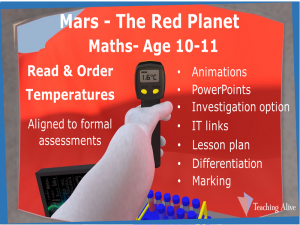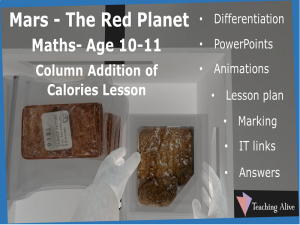Lessons that are available will have an ‘Open Lesson’ button visible next to them to access the lesson’s plans and resources.
Click on the relevant button below to find out more information about the unit or to access the unit’s outcomes and national curriculum objectives.
| Day | LO | Starter | Main | Activity | Plenary | |
| 4 | To recall and use multiplication facts. To multiply numbers up to 4 digits by a one-digit number. To multiply numbers up to 4 digits by a two-digit number. | Introduce the idea of rationing to conserve food to survive by watching Scene 04. (PP65M.4.1-Slides 3-5) | Look at the problem of calculating how many calories are needed until rescue even if we ration. Establish that we need to multiply the rationed calories by how many days until rescue. Recap column multiplication. (PP65M.4.1-Slides 6-40 & TC65M.4.1) | Consolidate multiplication facts and column multipplication. Investigate multiplication only using the numbers 2, 3, 5 and 7 (PC65M.4.1-PC65M.4.6) | Multiplication facts game |
| Day | LO | Starter | Main | Activity | Plenary | |
| 5 | To use multiplication facts to divide numbers. To use multiplication facts to divide numbers with remainders. To divide large numbers by a one digit number. | Introduce problems and discuss strategies (PP65M.5.1-Slide 3). | Watch Scene 05 which continues the fictional context of being an astronaut stranded on Mars planning to share food packs and grow potatoes if needed. Discuss the problem in terms of calories and establish that we need to divide the number of calories by how many astronauts there are. Look at division and division with remainders moving on to dividing larger numbers using the short method. (PP65M.5.1-Slides 4-28) | Recall division facts, divide with remainders and divide large numbers using the short method. Investigate sharing ration packs between astronauts. (PC65M.4.1) & (PC65M.5.1-PC65M.5.6) | Discuss any common mistakes and issues. |
| Day | LO | Starter | Main | Activity | Plenary | |
| 6 | To find the perimeter of shapes | Introduce problems and discuss strategies. (PP65M.6.1-Slide 3) | Watch Scene 06 which continues the fictional context of being an astronaut stranded on Mars attempting to contact Earth by finding a satellite. Discuss the problem of repairing the satellite looking at holes in its solar panels and how we need to know the distance around the outside of the hole i.e. its perimeter. Model finding the perimeter by rectangles and compound shapes with missing measurements. (PP65M.6.1-Slides 4-25) | Find the perimeter of rectangles and compound shapes. Investigate by finding the missing measurements. (PP65M.6.1-Slides 26-28) | Look at compound shapes with different sides missing. (PP65M.6.1-Slide 29) |
| Day | LO | Starter | Main | Activity | Plenary | |
| 7 | To find the area of shapes | Introduce problems and discuss strategies. (PP65M.7.1-Slide 3) | Watch the final part of Scene 06 again. Discuss not just finding the perimeter of the hole in the solar panel but also the area of panel needed in order to communicate with Earth. Model finding the area of rectangles and compound shapes. (PP65M.7.1-Slides 4-30) | Find the area of rectangles and compound shapes. Investigate by finding the missing measurements or problem solving with area and perimeter. (PP65M.7.1-Slides 31-32 & PC65M.7.1-PC65M.7.7) | Recap original problem with learners taking part (PP65M.7.1-Slide 33) |
| Day | LO | Starter | Main | Activity | Plenary | |
| 8 | To measure the capacity of containers. To measure the volume of containers. | Watch Scene 07.1 and look at measuring capacity in millilitres and litres. (PP65M.8.1-Slides 3-9) | Watch Scene 07.2 (PP65M.8.2-Slide 2). Discuss volume and the difference between capacity and volume. Look at problems and discuss how to find volume. (PP65M.8.2-Slides 2-21) | Learners read simple scales to measure capacity or find the volume of cuboids. (PC65M.4.1 & PC65M.8.1-PC65M.8.5) | Discuss PC65M.8.5 Section B and/or C (PP65M.8.2-Slides 22 & 23) |
| Day | LO | Starter | Main | Activity | Plenary | |
| 9 | To name 3D shapes | Revise naming 2D shapes. (PP65M.9.1-Slides 3-4) | Watch Scene 08 and introduce the fact that we now need to describe the objects that we have found to Mission Control. Discuss the fact that the shapes are 3D and then look at a number of 3D shapes. (PP65M.9.1-Slides 5-29) | Name 3D shapes. Investigate describing shapes. (PC65M.9.1-PC65M.9.7) | Recap learning going through steps to success and actions. (PP65M.9.1-Slide 25) |
| Day | LO | Starter | Main | Activity | Plenary | |
| 10 | To make and describe 3D shapes *Lesson suitable for display |
Introduce problems and discuss strategies. (PP65M.10.1-Slide 3). | Watch Scene 09 continuing the Mars storyline. Revise describing 3D shapes looking at vertices, edges and faces. Explain that today we will be making 3D shapes in groups to be able to describe them to Mission control. Go through and repeat the steps in making 3D shapes. (PP65M.10.1-Slides 4-20) | Make and describe 3D shapes in groups. (SEN Teacher Shape Nets & PC65M.10.1) | Introduce Euler’s Formula. (PP65M.10.1-Slide 21) |
| Day | LO | Starter | Main | Activity | Plenary | |
| 11 | To explain our maths learning | Introduce problems and discuss strategies. (PP65M.11.1-Slide 3). | Watch Scene 10.1 and explain that they will have to create a video diary as if they were the astronauts stranded in Mars. In groups, learners will have to explain the situation and also explain the maths that we used for each question being clear in the steps to success needed in each case. (PP65M.11.1-Slides 4-45) | Work as a group to plan and act out a video diary stranded on Mars explaining mathematical concepts to help us survive. (PP65M.11.1-Slides 12-18, Slides 22-29, Slides 33-39, PC65M.11.1, PC65M.4.1) | Evaluate video diaries in progress ticking off steps to success. (PP65M.11.1-Slide 46) |
| Day | LO | Starter | Main | Activity | Plenary | |
| 12 | To explain our maths learning | Introduce problems and discuss strategies. (PP65M.12.1-Slide 3) | Discuss any problems in group work and review prior learning for today’s questions. Re-cap the steps to success and activities for the groups. (PP65M.12.1-Slides 4-55) | Continue to work as a group to plan and act out a video diary stranded on Mars explaining mathematical concepts to help us survive (PP65M.12.1-Slides 10-17, Slides 21-39, Slides 43-49, PC65M.11.1, PC65M.4.1) | Evaluate video diaries in progress ticking off steps to success. (PP65M.12.1-Slide 56) |
| Day | LO | Starter | Main | Activity | Plenary | |
| 13 | To explain our maths learning. To evaluate our maths learning. | Introduce problems and discuss strategies. (PP65M.13.1-Slide 3). | Discuss any problems in group work. Look at the evaluation table again related to our steps to success and explain each group will be rated for each question and then totalled in each area. (PP65M.13.1-Slides 4-13). | Groups have time to practise and then perform and evaluate. Groups assess each other and then themselves. (PC65M.13.1) | Evaluate whole process in creating video diaries. What can be improved and what needs to be covered again. |
| Day | LO | Starter | Main | Activity | Plenary | |
| 14 | To use strategies to answer procedural and reasoning Maths questions | Introduce problems and discuss strategies. (PP65M.14.1-Slide 3) | Review different types of maths questions and strategies. (PP65M.14.1-Slides 4-8) | Answer a range of questions. (PC65M.14.1-PC65M.14.3) | As a class, mark and evaluate questions. (PP65M.14.2-Slides 2-18) |
| Day | LO | Starter | Main | Activity | Plenary | |
| 15 | To use strategies to answer procedural and reasoning Maths questions | Introduce problems and discuss strategies. (PP65M.14.1-Slide 3) | Review different types of maths questions and strategies. (PP65M.14.1-Slides 4-8) | Answer a range of questions. (PC65M.14.1-PC65M.14.3) | As a class, mark and evaluate questions. (PP65M.14.2-Slides 2-18) |
| Day | LO | Starter | Main | Activity | Plenary | |
| 16 | To use strategies to answer procedural and reasoning Maths questions | Introduce problems and discuss strategies. (PP65M.14.1-Slide 3) | Review different types of maths questions and strategies. (PP65M.14.1-Slides 4-8) | Answer a range of questions. (PC65M.14.1-PC65M.14.3) | As a class, mark and evaluate questions. (PP65M.14.2-Slides 2-18) |
| Day | LO | Starter | Main | Activity | Plenary | |
| 17 | To evaluate our use of strategies to answer Maths questions. To use strategies to answer procedural and reasoning Maths questions. | Introduce problems and discuss strategies. (PP65M.15.1-Slide 3) | If needed, as a class, mark and evaluate any questions that were not covered in lesson 14. Organise the class into mixed ability groups. Remind the class about strategies in answering questions and explain rules to compete in a quiz. (PP65M.15.1-Slides 4-21, PP65M.15.2-Slides 4-22) | Groups answer mixed ability questions using multiple choice and lifelines to support. Make note of points and learners use of lifelines. | Reveal quiz scores and final positions. |
| Day | LO | Starter | Main | Activity | Plenary | |
| 18 | To use strategies to solve reasoning Maths problems | Introduce problems and discuss strategies. | Watch Scene 10.2 where we look at trying to attempt to escape Mars by using a Mars Lander. Investigate length looking at lander plans and weight when looking at the ideal lander weight to reach orbit. Investigate and model strategies to approach the problems. | Learners use similar strategies to attempt problems, with support | Discuss any issues and alternative approaches to problems |
| Day | LO | Starter | Main | Activity | Plenary | |
| 19 | To explain strategies to solve reasoning problems | Introduce problems and discuss strategies. | Explain that they will now add to their video diaries and explain how they have solved their problems to escape Mars. | Learners work in groups to present their strategies to solve reasoning problems. | Evaluate presentations |
| Day | LO | Starter | Main | Activity | Plenary | |
| 20 | To independently use strategies to answer reasoning Maths questions | Introduce problems and discuss strategies. | Remind learners of previously used strategies to solve reasoning problems | Learners independently answer reasoning problems. | Evaluate strategies used and mark as a class. |




